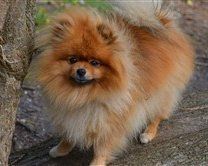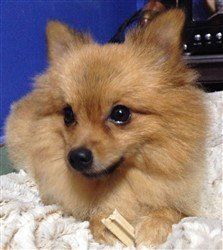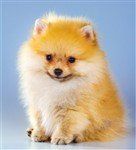Orange Pomeranians
Overview
Cookie, photo courtesy of Regina
While the Pomeranian breed can be found in an array of colors, it is orange that most people think about when picturing a Pom (at least non-Pom owners) and is the classic Pomeranian color. It is one of the oldest colors as well; however, even back in the 1700's there is mention of sables, brown (chocolate), white and creams.
The Pomeranian Project
has put an extensive amount of work into researching the development of this breed and lists the very first orange Pomeranian conformation winner in the UK as being Ch Mars.
His win occurred in 1907. He was not a 'perfect' orange Pom since this coat color should have a black nose and he had a brown nose, however his gait was ideal; so much so, that from that moment on, an ideal gait was referred to as 'Mars action'.
As mentioned, that first orange champion did not meet standards in regard to his nose coloring. In the show ring, orange Poms should have black points; this refers to the skin pigmentation of the eye rims, nose, lips, and paw pads. Nowadays, in show, anything other than this would result in major point reductions.
Orange with a Marking
This is Cheech, seen at 2 years old. He's an orange and white Pom.
Photo courtesy of Fefe, from Scotland.
If a Pomeranian is orange and has another color, that color is almost always white or cream. Yet having those 2 colors does not always mean that the Pom will be a
parti Pom (2 colored coat).
If the 2nd color can be considered just a small 'patch', the Pomeranian may be labeled an 'orange with white markings'.
99% of orange Poms with markings will have that secondary color appear on the head and/or chest and it may or may not be present on the paws. It would be exceedingly rare for an orange Pomeranian to have a sole patch of another color on a different area such as just his lower back or just his tail.
Levels of Orange
This is Zooey, a light orange Pom. Photo courtesy of Lyssa
While 'medium' orange is considered the classic Pom color, orange Pomeranians may range from a very light orange (almost like an apricot and this could be mistaken for a tan for those not familiar with the breed) to a very dark orange (if orange is very dark, one must consider classifying the
Pom as a red; genetic color testing can confirm this).
It is common for an orange Pom to appear to have fluctuating intensity of their color. Everything from the color of a chair they are resting on to the amount of natural sunlight when looking at them to the length of the hairs can affect just how orange they appear.
Also, if you look very closely at a light orange Pom, you may notice thin streaks of cream. This is usually not considered to be a secondary color or a marking, but rather a typical element of light oranges.
Orange Sable
This is Boo Bear, an orange sable Pom. Photo courtesy of Valerie Orlando
Sable refers to dark tipped hairs, so if a Pom has an orange base color and then has sabling, the Pom is an orange sable. This is true no matter the intensity of the orange, whether it be very light or super dark.
Sabling tends to change a lot when a Pom transitions through the puppy uglies, which is the phase in which the puppy fur falls out quite rapidly to be replaced by the final adult coat.
More often than not, the sable will decrease during this time, though the opposite can
sometimes happen. However, in many cases, an orange sable Pomeranian puppy will mature into an adult that has much more visible orange coat than their younger self as the sabling fades away.
Clearing
- When an orange Pomeranian has no dark tipped hairs at all, he is a 'clear orange'. If a Pom puppy is born with some black hairs (sabling) this is sometimes referred to as 'smuttiness' and if it all
falls off during the puppy ugly shed, exposing just
a shiny orange coat, this is referred to as 'clearing'. And then if the coat remains solely orange and free of any other colors, the Pom has 'cleared'.
Examples of Orange Poms
As we mentioned, orange has quite a range from super light (apricot or almost a peach) to deep and dark, bordering on red. Here, we take a fun look at a variety of beautiful Poms, all with their own unique orange coloring...

A pretty medium orange with a touch of cream. Bailey, photo courtesy of Patricia Gaduzo from Gibraltar

This orange is fiery! It doesn't get much brighter and shinier than this! Winnie, photo courtesy of AnnHelen

Orange sable; what a fluffy girl! Photo courtesy of Veronika J. Uricko (a breeder in Slowakia)

A soft, warm light orange.
Murphy, photo courtesy of Ruby Muescan

The darkest orange possible, bordering on red. Olivia, photo courtesy of Angela Soliz

A luscious, soft medium orange. Michka, photo courtesy of Paul and Christophe de Denis La Soie
You May Also Like:
Grooming a Pomeranian
- From baths to brushing, all of the grooming tasks that are required to keep a Pom looking great, with healthy skin and a shiny coat.
Pomeranian Dos and Don'ts
- A list of the most important dos and the most vital don'ts to keep a Pom healthy and safe. How many of these are you following and what changes can you make?
How to Take Care of a Pom's Teeth
- What you need to know about at-home dental care.
Helpful Advice and Recommendations:
Placing a Pomeranian in a Playpen
- How the right playpen can make a world of difference.






